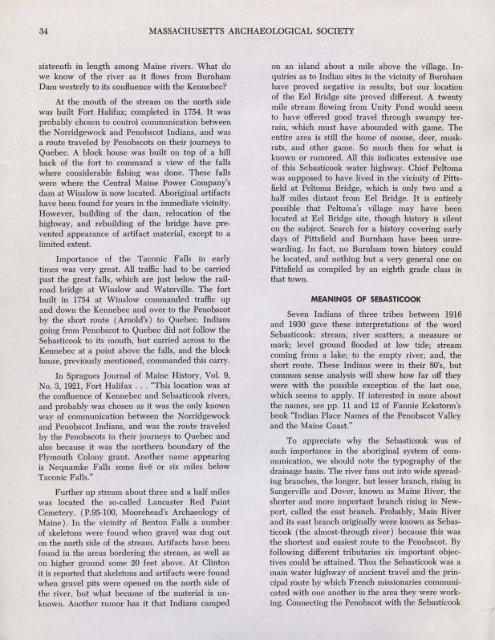No. 3/4
No. 3/4
No. 3/4
You also want an ePaper? Increase the reach of your titles
YUMPU automatically turns print PDFs into web optimized ePapers that Google loves.
34 MASSACHUSETTS ARCHAEOLOGICAL SOCIETY<br />
sixteenth in length among Maine rivers. What do<br />
we know of the river as it flows from Burnham<br />
Dam westerly to its confluence with the Kennebec?<br />
At the mouth of the stream on the north side<br />
was built Fort Halifax; completed in 1754. It was<br />
probably chosen to control communication between<br />
the <strong>No</strong>rridgewock and Penobscot Indians, and was<br />
a rotite traveled by Penobscots on their journeys to<br />
Quebec. A block house was built on top of a hill<br />
back of the fort to command a view of the falls<br />
where considerable fishing was done. These falls<br />
were where the Central Maine Power Company's<br />
dam at Winslow is now located. Aboriginal artifacts<br />
have been found for years in the immediate vicinity.<br />
However, building of the dam, relocation of the<br />
highway, and rebuilding of the bridge have prevented<br />
appearance of artifact material, except to a<br />
limited extent.<br />
Importance of the Taconic Falls in early<br />
times was very great. All traffic had to be carried<br />
past the great falls, which are just below the railroad<br />
bridge at Winslow and Waterville. The fort<br />
built in 1754 at Winslow commanded traffic up<br />
and down the Kennebec and over to the Penobscot<br />
by the short route (Arnold's) to Quebec. Indians<br />
going from Penobscot to Quebec did not follow the<br />
Sebasticook to its mouth, but carried across to the<br />
Kennebec at a point above the falls, and the block<br />
house, previously mentioned, commanded this carry.<br />
In Spragues Journal of Maine History, Vol. 9,<br />
<strong>No</strong>.3, 1921, Fort Halifax ... "This location was at<br />
the confluence of Kennebec and Sebasticook rivers,<br />
and probably was chosen as it was the only known<br />
way of communication between the <strong>No</strong>rridgewock<br />
and Penobscot Indians, and was the route traveled<br />
by the Penobscots in their journeys to Quebec and<br />
also because it was the northern boundary of the<br />
Plymouth Colony grant. Another name appearing<br />
is Nequamke Falls some five or six miles below<br />
Taconic Falls."<br />
Further up stream about three and a half miles<br />
was located the so-called Lancaster Red Paint<br />
Cemetery. (P.95-100, Moorehead's Archaeology of<br />
Maine). In the vicinity of Benton Falls a number<br />
of skeletons were found when gravel was dug out<br />
on the north side of the stream. Artifacts have been<br />
found in the areas bordering the stream, as well as<br />
on higher ground some 20 feet above. At Clinton<br />
it is reported that skeletons and artifacts were found<br />
when gravel pits were opened on the north side of<br />
the river, but what became of the material is unknown.<br />
Another rumor has it that Indians camped<br />
on an island about a mile above the village. Inquiries<br />
as to Indian sites in the vicinity of Burnham<br />
have proved negative in results; but our location<br />
of the Eel Bridge site proved different. A twenty<br />
mile stream flowing from Unity Pond would seem<br />
to have offered good travel through swampy terrain,<br />
which must have abounded with game. The<br />
entire area is still the home of moose, deer, muskrats,<br />
and other game. So much then for what is<br />
known or rumored. All this indicates extensive use<br />
of this Sebasticook water highway. Chief Peltoma<br />
was supposed to have lived in the vicinity of Pittsfield<br />
at Peltoma Bridge, which is only two and a<br />
half miles distant from Eel Bridge. It is entirely<br />
possible that Peltoma's village may have been<br />
located at Eel Bridge site, though history is silent<br />
on the subject. Search for a history covering early<br />
days of Pittsfield and Burnham have been unrewarding.<br />
In fact, no Burnham town history could<br />
be located, and nothing but a very general one on<br />
Pittsfield as compiled by an eighth grade class in<br />
that town.<br />
MEANINGS OF SEBASTICOOK<br />
Seven Indians of three tribes between 1916<br />
and 1930 gave these interpretations of the word<br />
Sebasticook: stream; river scatters; a measure or<br />
mark; level ground flooded at low tide; stream<br />
coming from a lake; to the empty river; and, the<br />
short route. These Indians were in their 80's, but<br />
common sense analysis will show how far off they<br />
were with the possible exception of the last one,<br />
which seems to apply. If interested in more about<br />
the names, see pp. 11 and 12 of Fannie Eckstorm's<br />
book "Indian Place Names of the Penobscot Valley<br />
and the Maine Coast."<br />
To appreciate why the Sebasticook was of<br />
such importance in the aboriginal system of communication,<br />
we should note the typography of the<br />
drainage basin. The river fans out into wide spreading<br />
branches, the longer, but lesser branch, rising in<br />
Sangerville and Dover, known as Maine River, the<br />
shorter and more important branch rising in Newport,<br />
called the east branch. Probably, Main River<br />
and its east branch originally were known as Sebasticook<br />
(the almost-through river) because this was<br />
the shortest and easiest route to the Penobscot. By<br />
following different tributaries six important objectives<br />
could be attained. Thus the Sebasticook was a<br />
main water highway of ancient travel and the principal<br />
route by which French missionaries communicated<br />
with one another in the area they were working.<br />
Connecting the Penobscot with the Sebasticook

















